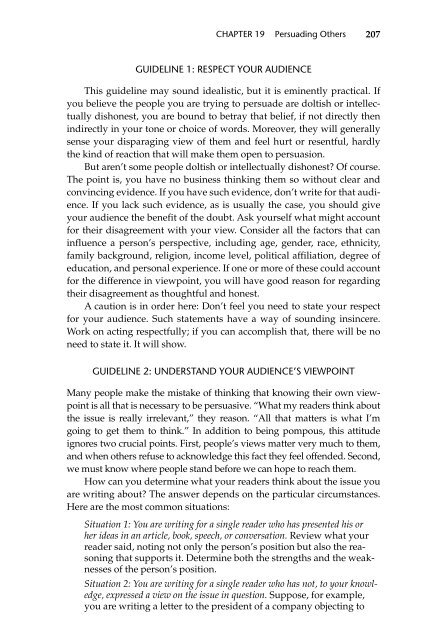Beyond Feelings
Beyond Feelings
Beyond Feelings
Create successful ePaper yourself
Turn your PDF publications into a flip-book with our unique Google optimized e-Paper software.
CHAPTER 19 Persuading Others<br />
GUIDELINE 1: RESPECT YOUR AUDIENCE<br />
207<br />
This guideline may sound idealistic, but it is eminently practical. If<br />
you believe the people you are trying to persuade are doltish or intellectually<br />
dishonest, you are bound to betray that belief, if not directly then<br />
indirectly in your tone or choice of words. Moreover, they will generally<br />
sense your disparaging view of them and feel hurt or resentful, hardly<br />
the kind of reaction that will make them open to persuasion.<br />
But aren’t some people doltish or intellectually dishonest? Of course.<br />
The point is, you have no business thinking them so without clear and<br />
convincing evidence. If you have such evidence, don’t write for that audience.<br />
If you lack such evidence, as is usually the case, you should give<br />
your audience the benefit of the doubt. Ask yourself what might account<br />
for their disagreement with your view. Consider all the factors that can<br />
influence a person’s perspective, including age, gender, race, ethnicity,<br />
family background, religion, income level, political affiliation, degree of<br />
education, and personal experience. If one or more of these could account<br />
for the difference in viewpoint, you will have good reason for regarding<br />
their disagreement as thoughtful and honest.<br />
A caution is in order here: Don’t feel you need to state your respect<br />
for your audience. Such statements have a way of sounding insincere.<br />
Work on acting respectfully; if you can accomplish that, there will be no<br />
need to state it. It will show.<br />
GUIDELINE 2: UNDERSTAND YOUR AUDIENCE’S VIEWPOINT<br />
Many people make the mistake of thinking that knowing their own viewpoint<br />
is all that is necessary to be persuasive. “What my readers think about<br />
the issue is really irrelevant,” they reason. “All that matters is what I’m<br />
going to get them to think.” In addition to being pompous, this attitude<br />
ignores two crucial points. First, people’s views matter very much to them,<br />
and when others refuse to acknowledge this fact they feel offended. Second,<br />
we must know where people stand before we can hope to reach them.<br />
How can you determine what your readers think about the issue you<br />
are writing about? The answer depends on the particular circumstances.<br />
Here are the most common situations:<br />
Situation 1: You are writing for a single reader who has presented his or<br />
her ideas in an article, book, speech, or conversation. Review what your<br />
reader said, noting not only the person’s position but also the reasoning<br />
that supports it. Determine both the strengths and the weaknesses<br />
of the person’s position.<br />
Situation 2: You are writing for a single reader who has not, to your knowledge,<br />
expressed a view on the issue in question. Suppose, for example,<br />
you are writing a letter to the president of a company objecting to


